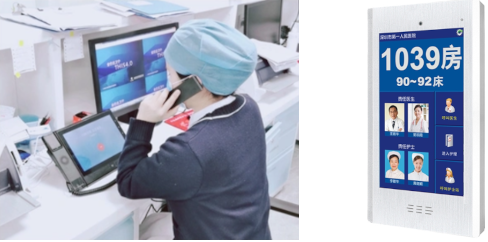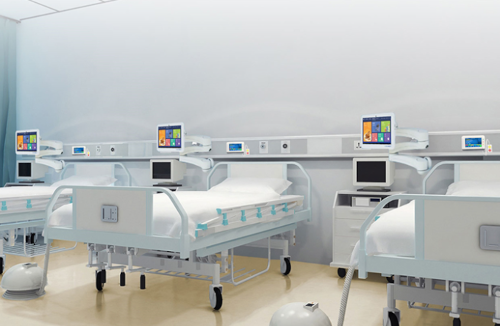TFT LCD's Application Brings New Experience to Wards
As technology rapidly advances, the healthcare sector is undergoing unprecedented transformations. Among these, smart wards have emerged as a pivotal aspect of modernizing hospitals. Thin-Film Transistor Liquid Crystal Displays (TFT LCDs), with their outstanding display performance, high resolution, low power consumption, and broad adaptability, play an indispensable role in this transformation. Their integration into smart wards significantly enhances patient experience and healthcare efficiency.
Understanding TFT LCD Technology
TFT LCDs, or Thin-Film Transistor Liquid Crystal Displays, operate based on the properties of liquid crystal materials and thin-film transistor technology. Liquid crystals are unique substances that exist between solid and liquid states, featuring elongated molecular structures. These molecules can change orientation under an electric field, thereby altering light transmission. TFT LCDs achieve image display by embedding liquid crystal materials between two parallel glass substrates, with each pixel controlled by a thin-film transistor (TFT).
When a TFT receives signals from the driving circuit, it manipulates the orientation of the liquid crystal molecules at the pixel, altering the light transmission to display different grayscale levels or colors. Each pixel is independently controlled, allowing TFT LCDs to deliver high resolution, high contrast, and fast response time.
Advantages of TFT LCDs Used in Smart Wards
Smart wards incorporate multiple subsystems such as mobile nursing information systems, intelligent voice nursing interaction systems, bedside interaction systems, smart bedside cards, smart nameplates, and main nurse stations. By networking with existing hospital information systems (HIS, LIS, EMR), smart wards streamline patient and nursing information dissemination, enhancing data integration, improving diagnostic efficiency, and reducing the workload on medical staff.
The benefits of TFT LCDs in smart wards include:
1. Exceptional Display Quality: TFT LCDs provide high resolution, wide viewing angles, and excellent color saturation, ensuring that medical information is displayed clearly and accurately to both patients and healthcare staff. This enhances the efficiency and accuracy of information communication.
2. Excellent Visibility: TFT LCDs maintain wide viewing angles, allowing both patients and healthcare personnel to view screen content clearly from different angles without worrying about color distortion or brightness reduction.
3. Ease of Disinfection: The smooth surface of TFT LCDs, typically glass, is easy to clean and disinfect, meeting the high hygiene standards of medical environments. Professional disinfectant wipes or solutions can be used to clean the screens, ensuring a safe and hygienic ward environment. Additionally, TFT LCDs with touch functionality eliminate the need for mechanical buttons, reducing areas where dirt and germs can accumulate and freeing up panel space for critical information display.
4. Low Power Consumption and Environmental Friendliness: TFT LCDs consume less power compared to traditional display devices, helping to lower hospital operating costs and reduce energy consumption. Their longevity and stability also minimize waste generation, aligning with the trend towards greener healthcare solutions.
Specific Applications of Topway's TFT LCDs in Smart Wards
1. Nurse Station Terminal: This device retrieves patient data from the HIS, displaying ward bed status and patient details while supporting voice playback and patient communication. Topway's 10.1" and 12.1" TFT LCDs, with high-definition displays and built-in capacitive touchscreens, are ideal for this application.

2. Smart Nameplates: Installed outside patient rooms, these multimedia information screens display the attending doctor and responsible nurse information, aiding navigation for patients' families and healthcare staff. With built-in network capability, the 7-inch Smart TFT module allow for remote information update and control, significantly reducing management costs.
3. Bedside Patient Infotainment: These systems connect to the internet to support services like meal ordering, caregiver appointments, payments, and patient education, creating an integrated ward interaction platform. A 15-inch touch-enabled TFT color screen with 1024x768 resolution can display comprehensive content, allowing patients to interact with the system using familiar touch gestures.

4. Smart Bedside Cards: Replacing traditional paper cards, these smart cards integrate with HIS interfaces to display patient information, test results, care information, and medical orders. They facilitate real-time interaction between the patient and nursing system, ensuring timely communication and efficient management.
Conclusion
Through TFT LCD screens, patients can easily access their basic information, medical instructions, and test results, enhancing their informed participation in their care. Healthcare professionals can interact with patients via touchscreens, inputting care records and adjusting treatment plans, thus improving work efficiency and patient satisfaction. The high definition and wide viewing angles of TFT LCDs also support remote consultations and medical training, enhancing the capabilities of healthcare teams.
In smart wards, TFT LCDs not only improve the display and interaction of medical information but also optimize medical workflows, boosting work efficiency and patient satisfaction. As technology continues to advance, the application of TFT LCDs in intelligent healthcare will become increasingly critical, driving further innovation and efficiency in medical care.
